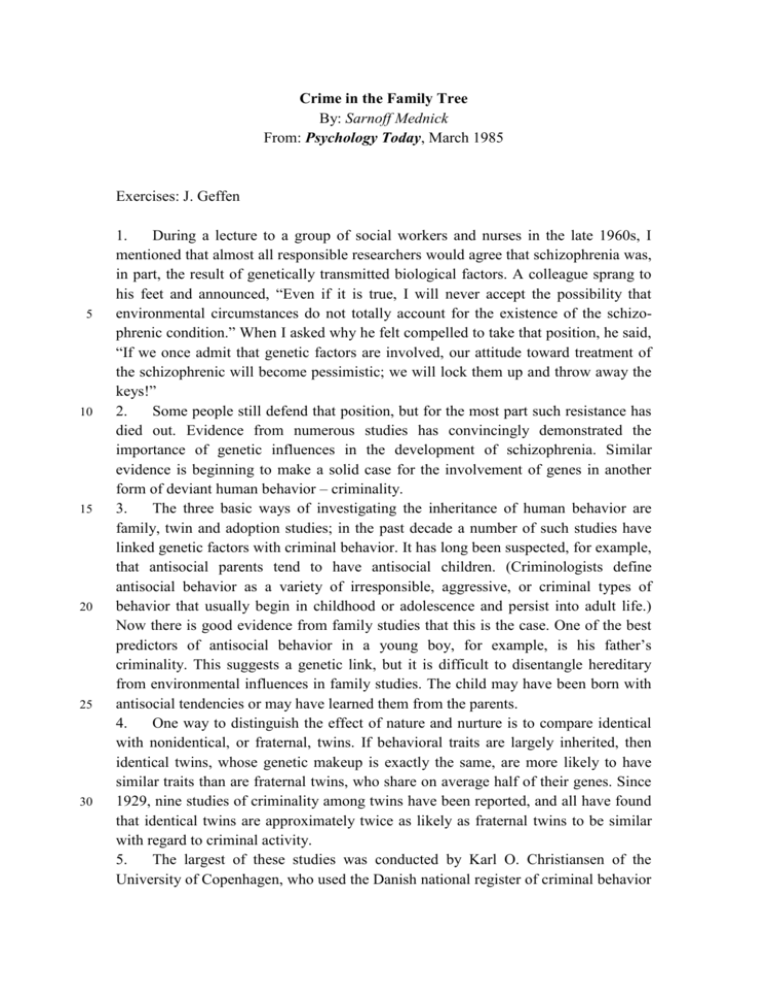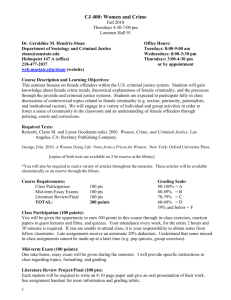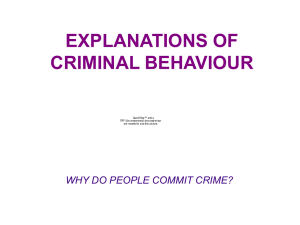Exercises: J. Geffen
advertisement

Crime in the Family Tree By: Sarnoff Mednick From: Psychology Today, March 1985 Exercises: J. Geffen 5 10 15 20 25 30 1. During a lecture to a group of social workers and nurses in the late 1960s, I mentioned that almost all responsible researchers would agree that schizophrenia was, in part, the result of genetically transmitted biological factors. A colleague sprang to his feet and announced, “Even if it is true, I will never accept the possibility that environmental circumstances do not totally account for the existence of the schizophrenic condition.” When I asked why he felt compelled to take that position, he said, “If we once admit that genetic factors are involved, our attitude toward treatment of the schizophrenic will become pessimistic; we will lock them up and throw away the keys!” 2. Some people still defend that position, but for the most part such resistance has died out. Evidence from numerous studies has convincingly demonstrated the importance of genetic influences in the development of schizophrenia. Similar evidence is beginning to make a solid case for the involvement of genes in another form of deviant human behavior – criminality. 3. The three basic ways of investigating the inheritance of human behavior are family, twin and adoption studies; in the past decade a number of such studies have linked genetic factors with criminal behavior. It has long been suspected, for example, that antisocial parents tend to have antisocial children. (Criminologists define antisocial behavior as a variety of irresponsible, aggressive, or criminal types of behavior that usually begin in childhood or adolescence and persist into adult life.) Now there is good evidence from family studies that this is the case. One of the best predictors of antisocial behavior in a young boy, for example, is his father’s criminality. This suggests a genetic link, but it is difficult to disentangle hereditary from environmental influences in family studies. The child may have been born with antisocial tendencies or may have learned them from the parents. 4. One way to distinguish the effect of nature and nurture is to compare identical with nonidentical, or fraternal, twins. If behavioral traits are largely inherited, then identical twins, whose genetic makeup is exactly the same, are more likely to have similar traits than are fraternal twins, who share on average half of their genes. Since 1929, nine studies of criminality among twins have been reported, and all have found that identical twins are approximately twice as likely as fraternal twins to be similar with regard to criminal activity. 5. The largest of these studies was conducted by Karl O. Christiansen of the University of Copenhagen, who used the Danish national register of criminal behavior Crime in the Family Tree / 2 5 10 15 20 25 30 35 40 to investigate the fates of 7,172 twins born in Denmark. He reported, in 1978, that 35 percent of the identical twins, compared with only 13 percent of the fraternal twins, were similar as far as criminal activity (or lack of it) was concerned. 6. These findings point out the importance of both the environment and genes in the development of criminality. The fact that 65 percent of the identical twins did not have similar records of criminality suggests that the environment is critically important. But the identical twins were almost three times as likely as the fraternal twins to be alike, suggesting that there is some shared genetically controlled characteristic that in some as yet unknown way increases their risk of eventually becoming criminals. 7. Twin studies go a long way toward demonstrating the possible heritability of criminal behavior, but they too can be criticized. One problem is that identical twins are treated more alike than are fraternal twins and, therefore, are more likely to develop similar behavior patterns. Since they have more similar environments than do fraternal twins, there is a less than ideal separation of genetic and environmental influences. 8. Adoption studies avoid this problem by comparing children adopted at birth with their biological parents, with whom they share no environment. If both the biological parents and the adopted-away children have similar records of criminality, it suggests that the parents have passed on some characteristic that increases the risk of conviction. 9. At the 1974 meeting of the American Psychopathological Association, my colleague Barry Hutchings and I reported our findings from a study of 5,483 adoptions in Copenhagen. The rate of criminal behavior in the adopted-away sons of criminal fathers was considerably higher than the rate in boys whose fathers were not registered in the police files. At the same meeting, Raymond Crowe of the University of Iowa reported on the psychopathology of 46 adopted-away children in Iowa who had been born to imprisoned women. He found that six of these children, but only one of a similar group of adoptees born to non-criminal women, had antisocial personality disorders. In 1978, Remi Cadoret of the University of Iowa reported on a study of 246 Iowans adopted at birth. He found a close relationship between the antisocial behavior of the adoptees and that of their biological parents. Other researchers have found similar correlations for psychiatric hospitalization and convictions for property crime between adopted-away children and their biological parents. 10. These studies all suggest that we should take seriously the idea that some biological characteristics that can be genetically transmitted may be involved in causing a person to become involved in criminal activity. To investigate this possibility further, Hutchings, William F. Gabrielli Jr. and I followed up on our earlier study by launching a full-scale investigation of the parents and children involved in all 14,427 adoptions registered in Denmark between 1927 and 1947. We hypothesized that court convictions for the biological parents would be associated with similar Crime in the Family Tree / 3 5 10 15 20 25 30 35 40 convictions for the adoptees. We also used this larger group to explore more detailed questions, such as repeat offenses, social status and the types of crimes. 11. We examined criminal court records for all adoptees and their biological and adoptive parents and found 65,516 convictions. In families in which neither a biological nor an adoptive parent had been convicted, only 13.5 percent of the sons had criminal records. (We concentrated on sons in our analysis because of the low conviction rate among women.) In families in which an adoptive but not a biological parent had been convicted, 14.7 percent of the sons had criminal records – not a significant difference from the first group. But if a biological parent rather than an adoptive parent had been convicted, 20 percent of the sons had criminal records. And the rate was even higher – 24.5 percent – if both an adoptive and a biological parent had court convictions. 12. Furthermore, we found that 4 percent of our adoptees accounted for almost 70 percent of the convictions. And these chronic offenders were more likely than the others to have biological parents with more than one conviction. Those whose biological parents had three or more convictions, for example, made up only 1 percent of the group that accounted for 30 percent of the criminal convictions. This extremely high rate of convictions among the very small number of the adoptees whose parents were multiple offenders suggests that a genetic predisposition plays an especially important role in their criminality. 13. Exactly what that role may be remains unknown, but our results suggest that it does not involve a tendency toward any particular kind of crime. Instead, any biological predisposition the adoptees inherits must be of a general nature, perhaps related to the capacity to learn to conform to family and social rules. 14. When we looked at the social and economic status of the family into which the child was adopted, we found support for the genetic theory. But we also found further proof of the interplay between nature and nurture in the development of criminality. Gabrielli, Katherine Van Dusen of the Psychological Institute Kommunehospitalet in Copenhagen and I found that children born to parents from the lowest social classes had the highest rates of criminality, no matter what type of family they were adopted into; however, those adopted by families of the lowest social and economic status were almost 40 percent more likely to have criminal convictions than the children adopted by families of the highest social class. Regardless of genetic background, improved social conditions seem to reduce criminality. 15. Our basic research goal was to determine whether genetically influenced characteristics play a role in the development of antisocial behavior. But we could only address this question indirectly. Our measure of antisocial behavior consisted of a decision by the courts that our subjects had committed crimes. However, we know that there is far more crime than is detected, charged or brought to trial or that results in convictions. Many of these uncounted crimes may have been committed by persons we identified as having no convictions and others by chronic offenders convicted of Crime in the Family Tree / 4 5 10 15 20 25 30 35 40 only one or two crimes in our records. This undercounting reduced the likelihood that we would detect any genetic effect, yet we still found a significant one. 16. Our study, like others, strongly suggests that genetic influences can lead to the development of criminal behavior. And because genetic transmission can involve only biological factors, we conclude that biological characteristics must be responsible for some criminal behavior, especially that of multiple offenders. 17. If this is so, then ways of preventing criminal behavior might grow out of studies of its biological components, and the best place to start would be with the chronic offender. Attempts to identify potential multiple offenders early in their criminal careers generally are based on environmental factors, such as social and economic status, neighborhood, family circumstances and parenting practices. Our work suggests that biological factors should also be included, and certain biological markers have been identified that might be useful in predicting who is most likely to become a chronic offender. These include measures such as an extremely unresponsive autonomic system, slow brain-wave activity, neuropsychological deficits, biochemical abnormalities and a number of psychological and behavioral signs – impulsivity, aggressiveness and poor school performance. 18. Using such information, researchers could undertake a pilot project to help prevent the development of criminal behavior. They would begin by rating a large group of first offenders, perhaps 2,000 to 3,000 youths, on a carefully selected battery of environmental and biological measures. The findings would then be put aside until some of these youths began to become multiple offenders. The researchers would then go back to the original measures and see which combination best predicts chronic offending. With this list as a guide they would examine a new group of youthful first offenders and identify those most likely to become chronic offenders. They and their families would then be invited into a treatment program. 19. Participation would be entirely voluntary. The program probably would include a heavy emphasis on educational planning and occupational guidance and training. What we already know about chronic offenders suggests that they should not be guided into boring, repetitive, low-status positions. Instead, they should be directed toward relatively challenging, varied and demanding occupations that have the element of excitement that most chronic offenders seem to crave. The promise of such interesting jobs could make education more meaningful and give them a stake in society. 20. Critics of genetic theories of criminality have charged that the ability to predict criminal behavior would be abused, and that innocent people would suffer. But if we could accurately identify people likely to become criminals and develop programs to help them, it is much more probable that we would be opening the door to a better life for them, rather than locking them up and throwing away the keys. Note: Some treatment programs designed to prevent the development of antisocial behavior and delinquency already exist. Crime in the Family Tree / 5 Answer in your own words. 1. 2. 3. Answer the following question in English. Why did the author’s colleague – paragraph 1 – reject so fiercely the notion that schizophrenia might be traceable to biological factors? Answer: _____________________________________________________________ Answer the following question in English. Why need not the anti-social behaviour of a boy raised by criminal parents – paragraph 2 – be automatically attributed to genetic factors? Answer: _____________________________________________________________ Answer the following question in English. What do the studies of criminality – paragraph 4 – among twins suggest? Answer: _____________________________________________________________ Answer the following question in Hebrew. 4. How can the findings of studies of criminality among identical twins – paragraphs 4-6 – be understood as stressing the importance of both genetic and environmental factors? Answer: _____________________________________________________________ 5. 6. Answer the following question in English. What would the studies of children, who in spite of being separated at birth from their biological parents still share similar records of criminality, suggest? Answer: _____________________________________________________________ Answer the following question in English. What thesis is reinforced by the information provided in paragraph 9? Answer: _____________________________________________________________ Crime in the Family Tree / 6 7. Answer the following question in English. On what basis does the author suggest – paragraph 15 – that their measures of criminality are not entirely dependable and probably undercounted? Answer: _____________________________________________________________ Answer the following question in Hebrew. 8. How can even the bad news provided in paragraph 14 be interpreted optimistically? Answer: _____________________________________________________________ 9. 10. 11. Answer the following question in English. What measures should be adopted – paragraphs 17-18 – in an attempt to prevent criminal behaviour? Answer: _____________________________________________________________ Answer the following question in English. What personal characteristic – paragraph 19 – seems to distinguish the chronic offender? Answer: _____________________________________________________________ Answer the following question in English. What are the arguments of those supporting measures aimed at developing means of predicting criminal behaviour, and on what grounds – paragraph 20 – is such a policy opposed? Answer: _____________________________________________________________ Answer the following question in Hebrew. 12. What is the main idea in this article? Answer: _____________________________________________________________ Crime in the Family Tree / 7




![Application_trained_nurse[1] - Diversity Care Solutions Ltd](http://s3.studylib.net/store/data/006630267_1-c8ad234c03d998d961d0e759e03f1600-300x300.png)

